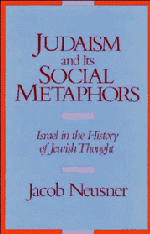Book contents
- Frontmatter
- Contents
- Preface
- List of Abbreviations
- Introduction
- 1 Imagining Society, Re-visioning “Israel”
- PART I “Israel” in the First Statement of Judaism, 70–300 C.E.
- PART II “Israel” in the Second Statement of Judaism, 300–600 C.E.
- 6 “Israel” on Its Own Terms
- 7 “Israel” as Family
- 8 “Israel” as Family and Also Singular Nation
- 9 “Israel” as Sui Generis
- 10 The Second Phase of the Judaism of the Dual Torah and Its Social Metaphors
- PART III Same Metaphors, Other Systems
- General Index
- Index to Biblical and Talmudic References
10 - The Second Phase of the Judaism of the Dual Torah and Its Social Metaphors
Published online by Cambridge University Press: 04 August 2010
- Frontmatter
- Contents
- Preface
- List of Abbreviations
- Introduction
- 1 Imagining Society, Re-visioning “Israel”
- PART I “Israel” in the First Statement of Judaism, 70–300 C.E.
- PART II “Israel” in the Second Statement of Judaism, 300–600 C.E.
- 6 “Israel” on Its Own Terms
- 7 “Israel” as Family
- 8 “Israel” as Family and Also Singular Nation
- 9 “Israel” as Sui Generis
- 10 The Second Phase of the Judaism of the Dual Torah and Its Social Metaphors
- PART III Same Metaphors, Other Systems
- General Index
- Index to Biblical and Talmudic References
Summary
Intransitive “Israel”
The single remarkable fact before us has proved so obvious as not to require much comment. It is the concrete and this-worldly way in which sages in the surveyed writings thought about “Israel.” The social component of their Judaism, “Israel” now circulated in discourse not as an abstraction but as a concrete and palpable social fact: a real group of people thoughtfully imagined, profoundly loved, intimately known – a social group in the concrete sense defined in Chapter 1. Thus “Israel” found definition in its own terms, meaning what “we” are absolutely, and not principally in terms of who, or what, an “Israel” – an “it” – was not. The reason that that concrete trait of mind is remarkable obviously derives from the comparison with the manner of thought about “Israel” and its definition that we found characteristic of the writings of the earlier phase in the formation of Judaism, the Mishnah and associated documents: “Israel” as against “non-Israel,” “Israel” as against Levite or priest. The categories that portray “Israel” not in relationship to “non-Israel” – for example, a family formed by a common genealogy and sustained by the shared inheritance of the merit of the ancestors, or Israel as sui generis and therefore a supernatural entity – served discourse only at severely limited points.
- Type
- Chapter
- Information
- Judaism and its Social MetaphorsIsrael in the History of Jewish Thought, pp. 184 - 204Publisher: Cambridge University PressPrint publication year: 1989



